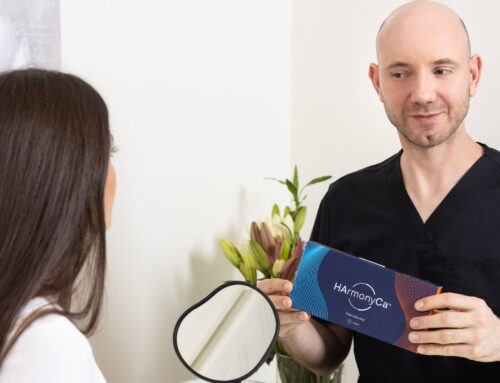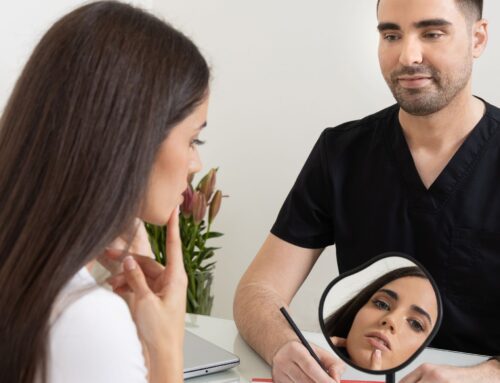Hyaluronic fillers are not only used as a means of filling wrinkles, regenerating the skin and removing signs of aging, but are also a very effective method in facial contouring procedures, removing aesthetic defects and highlighting natural facial contours.
The first step in this procedure is a conversation with the patient during which his needs are defined and we introduce him to the course and essence of the procedure. After that, there is a clinical examination of the face, subcutaneous tissue and skin, and diagnostics, which involves photographing the patient’s face in order to visually present to the patient the differences in the face that he can expect after the procedure.
In this phase, there are three basic aspects that we pay attention to during the examination of the patient’s face:
1. Face shape
2. Proportions of the face
3. Symmetry of the face
Although the beauty of one’s face is usually determined by harmonious proportion and symmetry, the very definition of an attractive and beautiful face is highly subjective and depends on a number of factors such as social, cultural and ethnic elements.
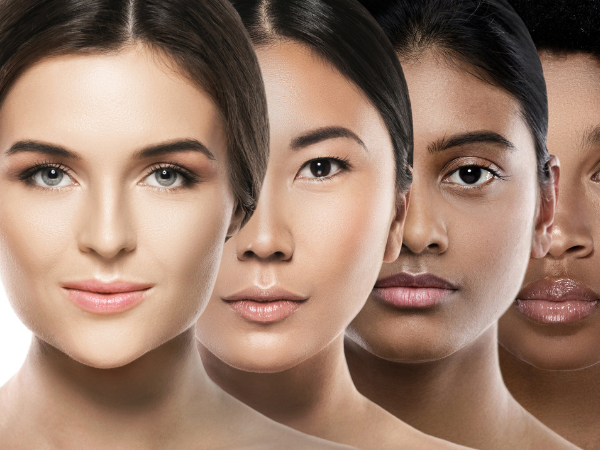
The beauty of the face depends on a number of factors, not only on symmetry and balance.
In the aesthetic assessment of the face, the wishes and needs of the patient should be taken into account, but also the realistic possibilities offered by this procedure should be established and the patient should be informed about it.
The aesthetic evaluation is based on the 3 factors mentioned above and is the foundation of the aesthetic procedure.
Face shape
Knowledge of the basic structure of the face and its shape leads to knowledge of the concept of balance and proportion. The analysis of the shape of the face is in many respects the basis for planning and forecasting the results of any aesthetic procedure.
When evaluating different morphologies, ie. the shape of the face, the following should be taken into account:
– The width of the forehead
– The width of the cheekbones
– Jaw length
– The length of the entire face
At the beginning of the 20th century, Rudolf Poch, an Austrian doctor, ethnologist and anthropologist, presented a theory about ten different face shapes. That theory served as the basis for a modern and more concise theory that divided and classified the shape of the face into 7 different categories:
1. An oval face is the ideal shape due to its balance and symmetry. It is characterized by a width in the central part of the face that narrows slightly towards the chin.
2. A round face is a face with clear and smooth features, without corners. It is widest in the area of the cheekbones and the length of the face is not much greater than the width. The jaw line is rounded and soft, the chin is short.
3. A square face is a wide face with an angular jawline and a square forehead.
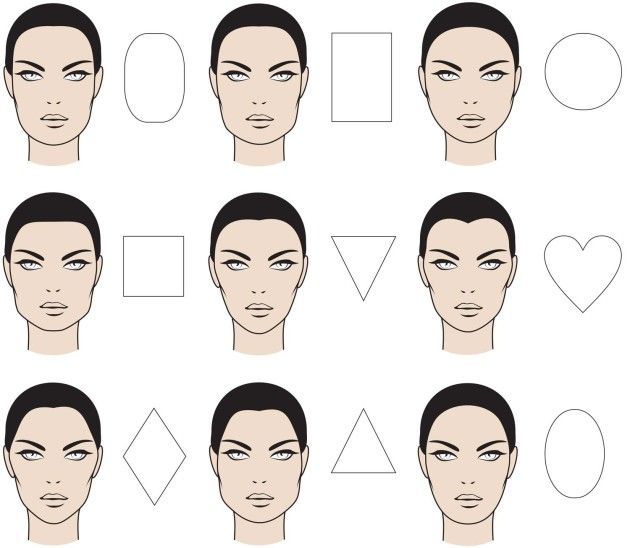
4. A triangular face has an accentuated volume in the lower area of the wide jaw that merges into the chin. The face narrows slightly towards the area of the temples and forehead.
5. The inverted triangle is characterized by a recessed and narrow jaw with a prominent chin, a wide forehead and accentuated cheekbones.
6. A rectangular face has straight features with a jagged jaw line, very similar to a square face but more elongated.
7. An oblong face is elongated and narrow. He is characterized by a narrower jaw, a long chin and prominent cheekbones.
Balance of facial proportions
When we analyze the proportions of the elements of the face, we divide it into horizontal thirds and vertical fifths.
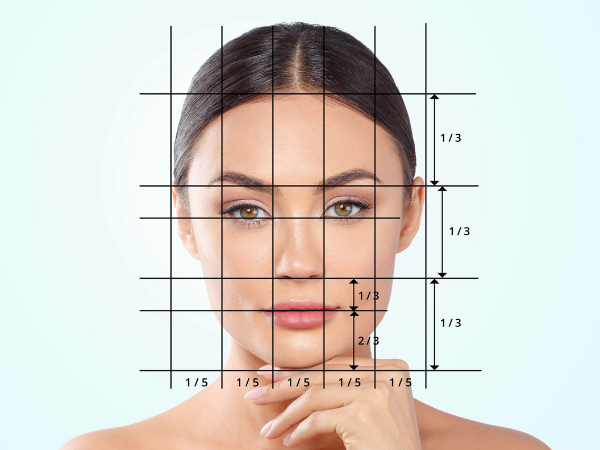
Vertical and horizontal division of the face.
Vertical fifths mean that the distance between the eyes is equal to the width of the nostril, the width of the eye, the width of the side face and the side eye. With horizontal thirds, the length of the nose is equal to the length of the lower face (nose to chin) and the length of the upper face (from the middle eyebrow to the hairline).
As we age, the relationship between these parts of the face changes, and even faces that were previously considered symmetrical tend to deviate from harmonious proportions. Thus, the distance between the mouth and the nose (philtrum) is lengthened, the fat around the eyes, cheekbones, the inner jaw line and the sides of the face disappear, and the loss of volume leaves an inflamed appearance and a face without contours.
By restoring the volume with hyaluronic fillers, it is possible to re-establish harmonious proportions, which will give the face a younger and more beautiful appearance.
In the analysis of facial contours, one of the methods we apply is determination Ricket’s “E” (Aesthetic) Lines –a line that runs from the tip of the nose to the tip of the chin, named after the orthodontist Dr. Rickett who recognized its importance for determining a harmonious profile. This concept allows us to correct defects in the form of an underdeveloped and receding chin as well as to enlarge the lips so that they fit into the existing anatomy.
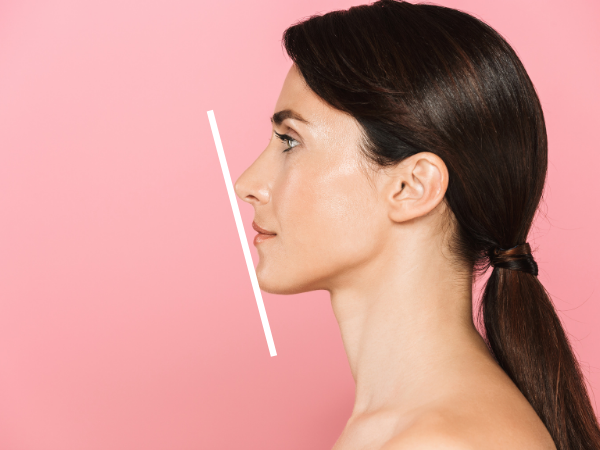
Ricket’s E-line.
Symmetry of the face
Facial symmetry represents the relationship between the left and right sides of the face in relation to the imaginary longitudinal axis that divides the face into two halves. Although symmetrical faces are recognized as more attractive than asymmetrical faces, we must remember that slight asymmetry is a normal phenomenon in most people and as such, gives a natural perception of the face, and in no case is it qualified as undesirable.
On the contrary, slight asymmetry gives the face authenticity and originality.

Asymmetry is what makes Jessica Alba recognizable and attractive, while her two symmetrical facial variants seem unattractive and unnatural.
Detailed analysis and plan to an attractive and harmonious appearance
After analyzing the shape, proportions and symmetry of the face, a detailed treatment plan is made that takes into account all the above elements as well as the needs and wishes of the patient.
The plan is made based on the horizontal and vertical areas of the face, where we determine the areas and types of aesthetic interventions that are needed and desired. For example, the lower horizontal third of the face can be lengthened using dermal fillers to balance the length of the forehead, nose and chin, or the outer parts of the vertical fifths can be extended – most commonly the cheekbones and lower jaw.
Some of the milder forms of jaw deformity, such as retrognathia, have a negative aesthetic impact on the rest of the face. In such cases, the application of hyaluronic fillers in the area of the lower jaw, the lower lip and the space between the lower lip and the chin (mental crease) can have positive effects on the entire face in a visual sense. In case of prognathism, the application of filler in the central area of the face also gives satisfactory aesthetic results.
In the aesthetic procedures we apply, the well-being and interest of our patients comes first, as well as their satisfaction with the result of the procedure. When we have a conversation with the patient that defines his wishes and needs, and then determine the goals of the aesthetic procedure, we move on to a detailed discussion about which approach and method is best for him and present the advantages and disadvantages of each method individually.
The goal of aesthetic treatment is not to create a perfect face, but rather to highlight the existing features and elements that define the patient’s face. In order to ensure the best possible results, we observe the face as a whole – at rest and in motion, take into account the condition of the skin and the thickness of the subcutaneous tissue, and thus arrive at the ideal method, a procedure that is uniquely tailored to the measurements and needs of the patient’s face.
The goal of the treatment is to emphasize those elements of the face that give it a note of individual beauty and originality, as well as correct or soften those aspects that could be characterized as less attractive.
In this regard, it is important to note that creating “standard shapes” or “cast faces” is something that should be avoided because it loses the individual character of the face.



